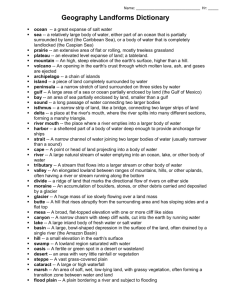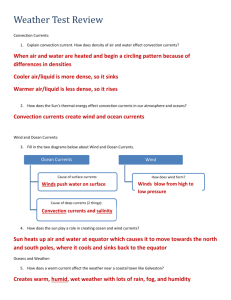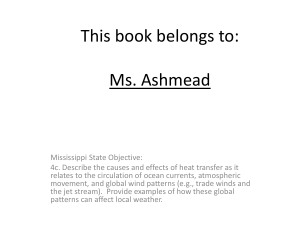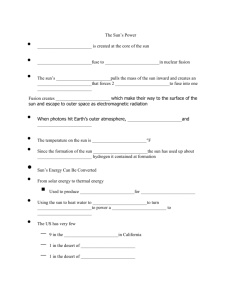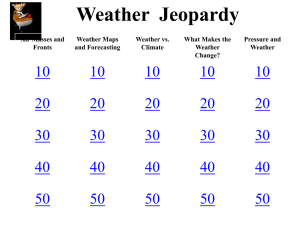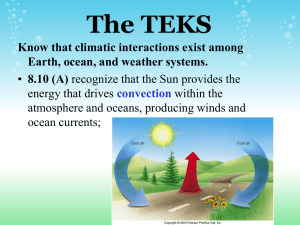oceans and climates - STEMTeachersNowPDProject
advertisement
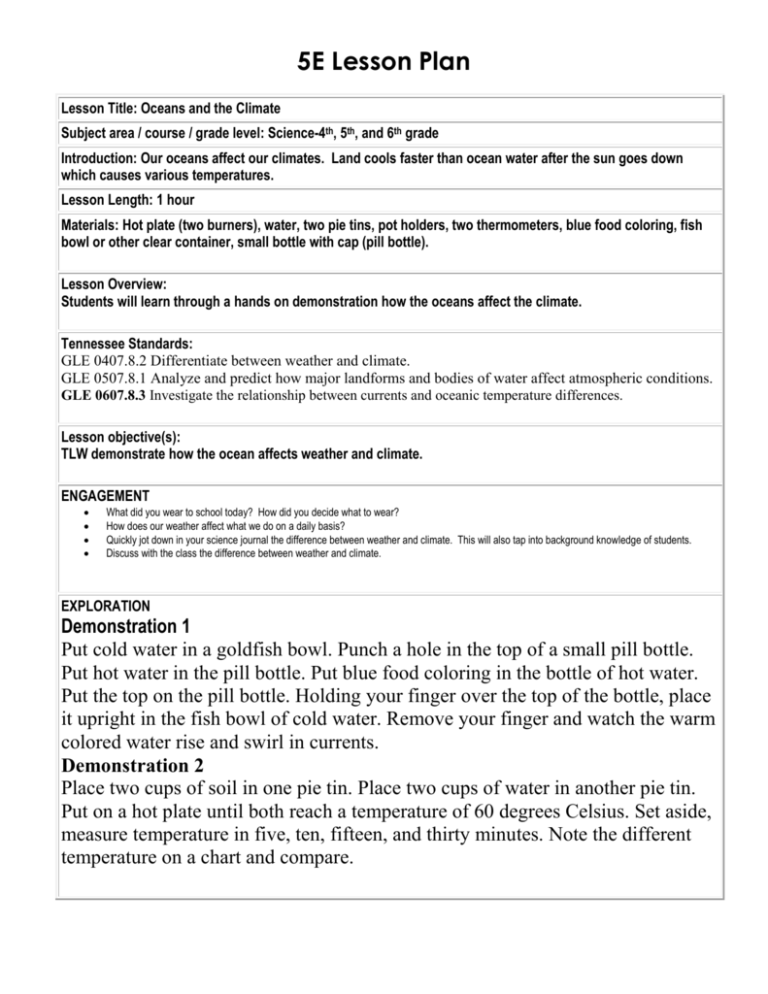
5E Lesson Plan Lesson Title: Oceans and the Climate Subject area / course / grade level: Science-4th, 5th, and 6th grade Introduction: Our oceans affect our climates. Land cools faster than ocean water after the sun goes down which causes various temperatures. Lesson Length: 1 hour Materials: Hot plate (two burners), water, two pie tins, pot holders, two thermometers, blue food coloring, fish bowl or other clear container, small bottle with cap (pill bottle). Lesson Overview: Students will learn through a hands on demonstration how the oceans affect the climate. Tennessee Standards: GLE 0407.8.2 Differentiate between weather and climate. GLE 0507.8.1 Analyze and predict how major landforms and bodies of water affect atmospheric conditions. GLE 0607.8.3 Investigate the relationship between currents and oceanic temperature differences. Lesson objective(s): TLW demonstrate how the ocean affects weather and climate. ENGAGEMENT What did you wear to school today? How did you decide what to wear? How does our weather affect what we do on a daily basis? Quickly jot down in your science journal the difference between weather and climate. This will also tap into background knowledge of students. Discuss with the class the difference between weather and climate. EXPLORATION Demonstration 1 Put cold water in a goldfish bowl. Punch a hole in the top of a small pill bottle. Put hot water in the pill bottle. Put blue food coloring in the bottle of hot water. Put the top on the pill bottle. Holding your finger over the top of the bottle, place it upright in the fish bowl of cold water. Remove your finger and watch the warm colored water rise and swirl in currents. Demonstration 2 Place two cups of soil in one pie tin. Place two cups of water in another pie tin. Put on a hot plate until both reach a temperature of 60 degrees Celsius. Set aside, measure temperature in five, ten, fifteen, and thirty minutes. Note the different temperature on a chart and compare. EXPLANATION To understand the effect that oceans have on weather and climate, one must first understand the concept of convection of heat. The transfer of heat by currents of air is called convection. A transfer of heat by currents of water is also convection. Particles of warm air or warm water move in convection currents from one place to another. When air becomes warm, it begins to move in a convection current. The warm air expands. It expands and moves upward. Heavier, cold air replaces the warm air. Many homes are heated with convection currents. Hot air flows into the room from a vent near the floor. The hot air rises and warms the room. Cold air drops to the floor. Convection also causes the breeze at the seashore. On a warm summer day, the land gets warmer than the ocean. During the afternoon, the land gives up some of its heat to the air. The hot air over the land rises. Cool air from the ocean moves in across the land. This cool air is a sea breeze. On a clear night, the land cools off faster than the ocean. The air over the land becomes cooler than the air over the ocean. The cooler land air moves out to sea. This is a land breeze. At the seashore you will note these changes in the direction of the wind. A sea breeze moves toward the land from the sea. A land breeze moves from the land toward the sea. The convection of heat can be observed in the oceans. Ocean water near the equator is heated by the sun. The warm water is lighter in weight than cold water farther north and south. Currents of warm water moving north and south are set up by this difference in weight. In the Atlantic Ocean, such a convection current is the Gulf Stream. The Gulf Stream follows the contours of the North American continent to the area of Cape Hatteras. The four capes of the southern Atlantic coast of the United States have been shaped by the section of the Gulf Stream as it moves north. The capes are Cape Kennedy, Cape Fear, Cape Lookout, and Cape Hatteras. Above Cape Hatteras, the Gulf Stream leaves the continental shelf. It becomes a narrow current. Meanwhile, the Labrador Current moves down from the north. It is a cold current. The cold Labrador Current pushes the warm Gulf Stream to the east. At times there is a twenty degree difference between the temperature of the Labrador Current and the Gulf Stream. The waters in each current run past each other, side by side. The Labrador Current has a green color to its water. The Gulf Stream is blue. As the Gulf Stream moves east across the Atlantic Ocean, it branches off into three different directions. One branch of the Gulf Stream goes south to the Sargasso Sea. Another flows into the Norwegian Sea. A third branch continues eastward to warm the coast of Europe. The Gulf Stream affects the climate in Europe. The temperature in England, for example, is higher than in most countries of the same latitude. The Gulf Stream gives England its extra warmth. Ocean currents are produced by many different things. Currents are made by the gravitational pull of the moon and sun, the prevailing winds blowing on the ocean surface and the unequal heating of the water by the rays of the sun. The ocean currents are also affected by the rotation of the earth. The general movement of the currents is clockwise in the Northern Hemisphere and counterclockwise in the Southern Hemisphere. ELABORATION Vocabulary-weather, climate, convection, atmosphere, conduction Who would use this type of information? What can you infer by examining the data of the soil and water temperatures? What do these two materials represent? Watch BrainPop video On Climates and one on Weather to finish out lesson. EVALUATION Recording data of land and water temperatures for science journal Answering questions throughout lesson.



